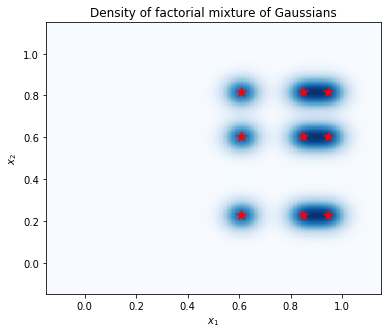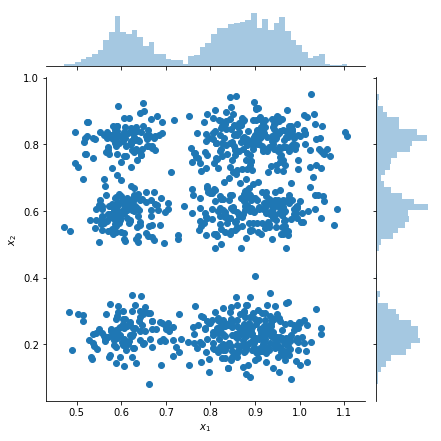 View on TensorFlow.org View on TensorFlow.org
|
 Run in Google Colab Run in Google Colab
|
 View source on GitHub View source on GitHub
|
 Download notebook Download notebook
|
In this notebook we show how to use TensorFlow Probability (TFP) to sample from a factorial Mixture of Gaussians distribution defined as: \(p(x_1, ..., x_n) = \prod_i p_i(x_i)\) where: \(\begin{align*} p_i &\equiv \frac{1}{K}\sum_{k=1}^K \pi_{ik}\,\text{Normal}\left(\text{loc}=\mu_{ik},\, \text{scale}=\sigma_{ik}\right)\\1&=\sum_{k=1}^K\pi_{ik}, \forall i.\hphantom{MMMMMMMMMMM}\end{align*}\)
Each variable \(x_i\) is modeled as a mixture of Gaussians, and the joint distribution over all \(n\) variables is a product of these densities.
Given a dataset \(x^{(1)}, ..., x^{(T)}\), we model each dataponit \(x^{(j)}\) as a factorial mixture of Gaussians:
\[p(x^{(j)}) = \prod_i p_i (x_i^{(j)})\]
Factorial mixtures are a simple way of creating distributions with a small number of parameters and a large number of modes.
import tensorflow as tf
import numpy as np
import tensorflow_probability as tfp
import matplotlib.pyplot as plt
import seaborn as sns
tfd = tfp.distributions
# Use try/except so we can easily re-execute the whole notebook.
try:
tf.enable_eager_execution()
except:
pass
Build the Factorial Mixture of Gaussians using TFP
num_vars = 2 # Number of variables (`n` in formula).
var_dim = 1 # Dimensionality of each variable `x[i]`.
num_components = 3 # Number of components for each mixture (`K` in formula).
sigma = 5e-2 # Fixed standard deviation of each component.
# Choose some random (component) modes.
component_mean = tfd.Uniform().sample([num_vars, num_components, var_dim])
factorial_mog = tfd.Independent(
tfd.MixtureSameFamily(
# Assume uniform weight on each component.
mixture_distribution=tfd.Categorical(
logits=tf.zeros([num_vars, num_components])),
components_distribution=tfd.MultivariateNormalDiag(
loc=component_mean, scale_diag=[sigma])),
reinterpreted_batch_ndims=1)
Notice our use of tfd.Independent. This "meta-distribution" applies a reduce_sum in the log_prob calculation over the rightmost reinterpreted_batch_ndims batch dimensions. In our case, this sums out the variables dimension leaving only the batch dimension when we compute log_prob. Note that this does not affect sampling.
Plot the Density
Compute the density on a grid of points, and show the locations of the modes with red stars. Each mode in the factorial mixture corresponds to a pair of modes from the underlying individual-variable mixture of Gaussians. We can see 9 modes in the plot below, but we only needed 6 parameters (3 to specify the locations of the modes in \(x_1\), and 3 to specify the locations of the modes in \(x_2\)). In contrast, a mixture of Gaussians distribution in the 2d space \((x_1, x_2)\) would require 2 * 9 = 18 parameters to specify the 9 modes.
plt.figure(figsize=(6,5))
# Compute density.
nx = 250 # Number of bins per dimension.
x = np.linspace(-3 * sigma, 1 + 3 * sigma, nx).astype('float32')
vals = tf.reshape(tf.stack(np.meshgrid(x, x), axis=2), (-1, num_vars, var_dim))
probs = factorial_mog.prob(vals).numpy().reshape(nx, nx)
# Display as image.
from matplotlib.colors import ListedColormap
cmap = ListedColormap(sns.color_palette("Blues", 256))
p = plt.pcolor(x, x, probs, cmap=cmap)
ax = plt.axis('tight');
# Plot locations of means.
means_np = component_mean.numpy().squeeze()
for mu_x in means_np[0]:
for mu_y in means_np[1]:
plt.scatter(mu_x, mu_y, s=150, marker='*', c='r', edgecolor='none');
plt.axis(ax);
plt.xlabel('$x_1$')
plt.ylabel('$x_2$')
plt.title('Density of factorial mixture of Gaussians');

Plot samples and marginal density estimates
samples = factorial_mog.sample(1000).numpy()
g = sns.jointplot(
x=samples[:, 0, 0],
y=samples[:, 1, 0],
kind="scatter",
marginal_kws=dict(bins=50))
g.set_axis_labels("$x_1$", "$x_2$");

